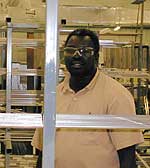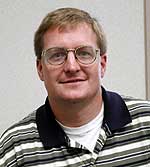By Bob Reha
Minnesota Public Radio
August 20, 2002
People in North Dakota are celebrating the new census numbers. The 2000 Census showed that for the first time in years, the state did not lose people. In fact, the state's population grew by slightly less than one percent. The gain is attributed to an influx of refugees escaping persecution and civil war. The majority of these new Americans have settled in Fargo, N.D.
| |
|
|
|
||
Foreign-born residents make up two percent of North Dakota's population. In Fargo, the numbers tell an interesting story. The majority of foreign-born residents come from Bosnia and Herzegovina, then Canada, followed closely by Africa.
Foreign-born residents make up four percent of Fargo's population, but 11 percent of those foreign-born residents are living below the poverty line. Census officials define that as an income of just over $17,000 for a family of four. For an individual, the figure is $8,500.
Refugees first starting arriving in Fargo-Moorhead 10 years ago. Amhar Lalic came from Bosnia seven years ago. Lalic is a team leader on the production line at Cardinal IG, a manufacturer of insulated glass windows. Lalic says he came here a poor refugee but he's not poor any more.
"Maybe a few years ago after I came here. But you know, everything changes, and over the years you build things up," says Lalic. "Right now I buy anything that I want. I don't have that kind of problem."
Lalic is in the majority at Cardinal IG. Of the company's 250 employees, 55 percent of them ae new Americans. Lalic says everyone gets along. He doesn't see many people complaining about their work. Lalic is an American citizen now, and enjoys living in the area.
"Nothing feels like home, but I feel like I'm welcomed here. I don't know how to explain it. They welcome me and ... they give me a job, and I'm happy with it," says Lalic.
| |
|
|
|
||
Obwono Ajang operates a machine the workers call a bender. It shapes aluminum into frames for the windows. Ajang arrived in Fargo more than three years ago from the Sudan. He says working is important to him. It's a way to establish his independence.
"The only way out for us is to work hard so that we can improve our living standard, because here we don't have relatives - we don't have nobody," Ajang says.
Starting pay at Cardinal IG is $7.15 per hour, $2 above minimum wage. The company also offers profit-sharing for its employees.
Production manager Mike Arntson says the company didn't recruit refugees for employment. He says Cardinal IG hires the best qualified applicants for the jobs. All they have to do is demonstrate a willingness to work hard, and give their best effort.
Arntson says he's surprised the large number of refugees working at the plant has gotten a lot of attention.
"People forget that this is the United States of America and that this is a very new country," Arntson says. "It wasn't 100 years ago - I know in my case, my grandparents and great-grandparents were new Americans."
Arntson says history is repeating itself. He says this is just the latest influx of people into the United States who will become a valuable part of the workforce.
"Maybe sometimes they feel more fortunate to be living here than some of us do," Arntson says.
According to census data, 11 percent of refugees living in Fargo-Moorhead aren't as fortunate as Cardinal IG employees. David Martin, director of public affairs for the Fargo-Moorhead Chamber of Commerce, says historically refugees have been able to improve their lives through education and hard work. He believes history will repeat itself.
"There are always going to be disparities, but I think that over time those things do level out," Martin says. "As people become more a part of the broader community, and as they are more in the community over a longer period of time, they have more economic opportunity as well."
Martin says there are signs that's beginning. This week, a number of Sudanese refugees are starting classes at area schools.
More from MPRMore Information


